If a trait A exists in 10% of a population of an asexually reproducing species and a trait B exists in 60% of the same population, which trait is likely to have arisen earlier?
Trait B becuause in asexual reproduction traits which are present in the previous generation are carried over to next generation with minimal variations. Trait B have higher percentage so it is likeliy to have arisen earlier.
Topper's Solved these Questions
Similar Questions
Knowledge Check
The given graph shows the range of variation among population members for a trait determined by multiple genes. If this population is subjected to disruptive selection for several generations, which of the following distributions is most likely to result?
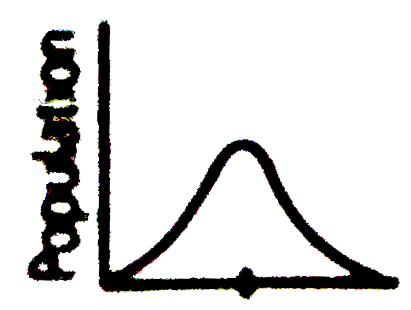 A
A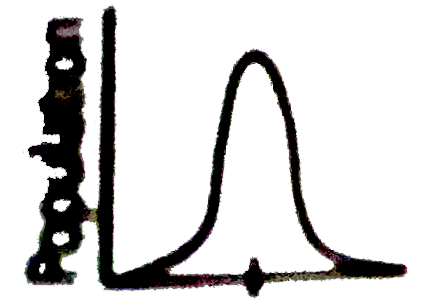 B
B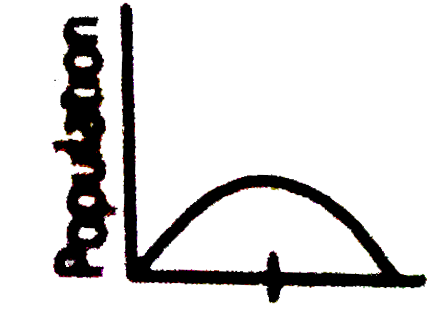 C
C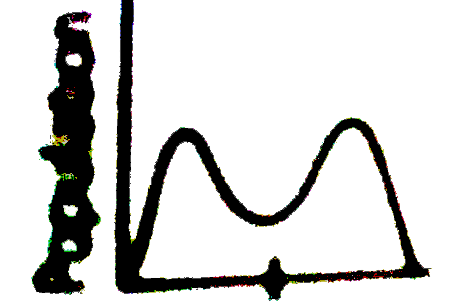 D
D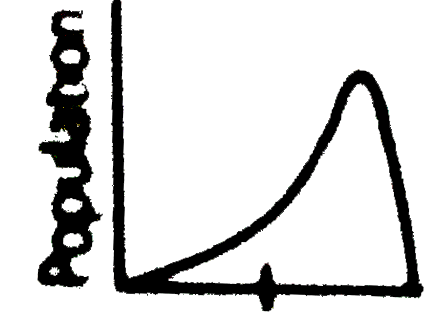
Which of the following statements describe natural extinction ?
(i) Extinctions abetted by human activities
(ii) Slow replacement of existing species
(iii) Also known as background extinction
(iv) A small population is most likely to be extinct
(a) (i) and (ii)
(b) (i), (ii) and (iii)
(c) (ii), (iii) and (iv)
(d) (i), (ii), (iii) and (iv)A(i) and (ii)B(i), (ii) and (iii)C(ii), (iii) and (iv)D(i), (ii), (iii) and (iv)There are few biochemical compounds as familiar to us as hemoglobin, and as the primary transporter of oxygen in our blood, the celebrity of this curious little compound is not without just cause. Vital to almost every known vertebrate, hemoglobin appears within the very first weel of embroyogenesis, and while its role may not change throughout development, its molecular structure undergoes a series of significant transformations. Within the red blood cell, hemoglobin exists as a four-subunit complex, or tetramer, " each subunit of which is made up of one" heme" metalloprotein, and one of several varieties of " globin." Comprised of iron and a carbon-nitrogen ring, heme is responsible for both the oxygen binding capacity of hemoglobin, and for the red coloration of blood. Globin, meanwhile, refers to a folded chain of polypeptides, and it is the combination of these tchains that imparts each type of hemoglobin with its unique characteristics. In humans, six globin chains are expressed sequentially throughout development embroynic hemoglobin, or HbE, is composed of two chains and two chains, both of which are expressedn exclusively during the embryonic period. In the fetal period, another tetramer of two chains and two chains emerges, and persists for the first six months of postnatal life. Due to its high affinity for binding gases, this fetal hemoglobin, or hbF, is able to extract oxygen from low-affinity maternal hemoglobin, and thus plays a crucial role in the oxygenation of fetal tissues. Like HbF, the final two physiologic hemoglobins, hbA and HbA2, also require a pair of a chains, and differ only in being coupled to two chains, and two chains, respectively. typically, both HbA and HbA2 are synthesized at fairly stable concentrations, though HbA is produced in far greater abundance. Given the tremendous import of these complexes, it should hardly be surprising that errors in their production can yield devastating results. What may be surprising, however, is that these errors_ including sickle-cell desease and thalassemia -are among the most common of all inherited genetic disorders, with an estimated 7% of the world's [population as carrirs, two -thirds of whom reside in Africa. Thalassemia describes a group of dis-orders in which either the a and b chian is quantitativelty reduced. Depending on the mutation, these defects can present with a wide range of anemia-related symptoms, and are particularly prevalent throughout africa, southeast asia, and the Mediterranean. This geographical distribution is anyting but random. Many studies have demonstrated that the production of suboptimal hemoglobin confers a degree of protection against maaria, a potentially deadly infectious disease caused by members of the plasmodium genus. which parazsitize red blood cells. It follows, then that whereas in many regions throughout the world thalassemia may merely constitute disease, in those where malaria is endemic, it represents a favorable evolutionary advantage. Owing to a redundancy in the human genome, thee are four copies of the a globin gene, whi two a -coding regions on weach copy of chromosome 16. For this reason, the spectyrum of severtiy in a thalassemia is particularly broad. For instance, deletion of a single gene will result in a carrier state, and is unlikely to cause clinically acute symptoms. Deletin of all four, meanwhile, leads to a precipitation during the fetal period of nonfunctional y tetramers, also called Hb Barts, and is universally lethal in utero. Similarly. A deletion of three copies typically results in a serious but survivable anemia, and is characterized by the formation of hb barts in the fetal period, and nonfunctional b tetramers, termed HbH, through out adulthood. Predictably, a deletion of two copies produces a still milder anemia, but can be subclassified based on whether the deletions occur on the same chromo some, termed cis deletion. or on opposite chromosomes, termed trans deletion. The trans subtype appears more commonly in the mediterranean, while cis is more often found in Asia. Notably it has been suggested that the cis deletion may contribure to the relatively higher rates of failed prognancies observed in this part of the world. Like its a counterpart, b thalassemia also impairs the production of HbA. However, the symptoms of B thalassemia will not become evident until after the first six months of life, when the concentration of HbF wanes to a critical threshold. Often, a compensatory upregulation in the expression of HbA2 occurs in affected individuals, the effects of which can be pharmaceutically augmented by a drug called hydroxyurea, which induces the expression of HbF in children and adults.
25. Which option gives the best evidence for the answer the previous question?ALines 11-15 (" Within … globin")BLines 15-16 (" Comprised . . . Ring")CLines 16-19 (" heme .. .. Blood")DLines 19-22 (" Globin . .. . Characteristics")
A farmer has a supply of chemical fertilizer of type. A which 10% nitrogen and 6% phosphoric acid and of type B which contains 5% nitrogen and 10% phosphoric acid. After soil test, it is found that at least 7kg of nitrogen and same quantity fo phosphoric acid is required for a good crop. The fertilizer of type A costs 5.00 per kg and the type B costs 8.00 per kg. Using Linear programming, find how many kilograms of each type of the fertilizer should be bought to meet the requirement and for the cost to be minimum. Find hte feasible region in the graph.
View SolutionA test for detection of a particular disease is not fool proof. The test will correctly detect the disease 90% of the time, but will incorrectly detect the disease 1% of the time. For a large population of which an estimated 0.2% have the disease, a person is selected at random, given the test, and tod that he has the disease. What are the chances that the person actually have the disease?
View SolutionThere are few biochemical compounds as familiar to us as hemoglobin, and as the primary transporter of oxygen in our blood, the celebrity of this curious little compound is not without just cause. Vital to almost every known vertebrate, hemoglobin appears within the very first weel of embroyogenesis, and while its role may not change throughout development, its molecular structure undergoes a series of significant transformations. Within the red blood cell, hemoglobin exists as a four-subunit complex, or tetramer, " each subunit of which is made up of one" heme" metalloprotein, and one of several varieties of " globin." Comprised of iron and a carbon-nitrogen ring, heme is responsible for both the oxygen binding capacity of hemoglobin, and for the red coloration of blood. Globin, meanwhile, refers to a folded chain of polypeptides, and it is the combination of these tchains that imparts each type of hemoglobin with its unique characteristics. In humans, six globin chains are expressed sequentially throughout development embroynic hemoglobin, or HbE, is composed of two chains and two chains, both of which are expressedn exclusively during the embryonic period. In the fetal period, another tetramer of two chains and two chains emerges, and persists for the first six months of postnatal life. Due to its high affinity for binding gases, this fetal hemoglobin, or hbF, is able to extract oxygen from low-affinity maternal hemoglobin, and thus plays a crucial role in the oxygenation of fetal tissues. Like HbF, the final two physiologic hemoglobins, hbA and HbA2, also require a pair of a chains, and differ only in being coupled to two chains, and two chains, respectively. typically, both HbA and HbA2 are synthesized at fairly stable concentrations, though HbA is produced in far greater abundance. Given the tremendous import of these complexes, it should hardly be surprising that errors in their production can yield devastating results. What may be surprising, however, is that these errors_ including sickle-cell desease and thalassemia -are among the most common of all inherited genetic disorders, with an estimated 7% of the world's [population as carrirs, two -thirds of whom reside in Africa. Thalassemia describes a group of dis-orders in which either the a and b chian is quantitativelty reduced. Depending on the mutation, these defects can present with a wide range of anemia-related symptoms, and are particularly prevalent throughout africa, southeast asia, and the Mediterranean. This geographical distribution is anyting but random. Many studies have demonstrated that the production of suboptimal hemoglobin confers a degree of protection against maaria, a potentially deadly infectious disease caused by members of the plasmodium genus. which parazsitize red blood cells. It follows, then that whereas in many regions throughout the world thalassemia may merely constitute disease, in those where malaria is endemic, it represents a favorable evolutionary advantage. Owing to a redundancy in the human genome, thee are four copies of the a globin gene, whi two a -coding regions on weach copy of chromosome 16. For this reason, the spectyrum of severtiy in a thalassemia is particularly broad. For instance, deletion of a single gene will result in a carrier state, and is unlikely to cause clinically acute symptoms. Deletin of all four, meanwhile, leads to a precipitation during the fetal period of nonfunctional y tetramers, also called Hb Barts, and is universally lethal in utero. Similarly. A deletion of three copies typically results in a serious but survivable anemia, and is characterized by the formation of hb barts in the fetal period, and nonfunctional b tetramers, termed HbH, through out adulthood. Predictably, a deletion of two copies produces a still milder anemia, but can be subclassified based on whether the deletions occur on the same chromo some, termed cis deletion. or on opposite chromosomes, termed trans deletion. The trans subtype appears more commonly in the mediterranean, while cis is more often found in Asia. Notably it has been suggested that the cis deletion may contribure to the relatively higher rates of failed prognancies observed in this part of the world. Like its a counterpart, b thalassemia also impairs the production of HbA. However, the symptoms of B thalassemia will not become evident until after the first six months of life, when the concentration of HbF wanes to a critical threshold. Often, a compensatory upregulation in the expression of HbA2 occurs in affected individuals, the effects of which can be pharmaceutically augmented by a drug called hydroxyurea, which induces the expression of HbF in children and adults.
22. The general purpose of this passage is to
View SolutionThere are few biochemical compounds as familiar to us as hemoglobin, and as the primary transporter of oxygen in our blood, the celebrity of this curious little compound is not without just cause. Vital to almost every known vertebrate, hemoglobin appears within the very first weel of embroyogenesis, and while its role may not change throughout development, its molecular structure undergoes a series of significant transformations. Within the red blood cell, hemoglobin exists as a four-subunit complex, or tetramer, " each subunit of which is made up of one" heme" metalloprotein, and one of several varieties of " globin." Comprised of iron and a carbon-nitrogen ring, heme is responsible for both the oxygen binding capacity of hemoglobin, and for the red coloration of blood. Globin, meanwhile, refers to a folded chain of polypeptides, and it is the combination of these tchains that imparts each type of hemoglobin with its unique characteristics. In humans, six globin chains are expressed sequentially throughout development embroynic hemoglobin, or HbE, is composed of two chains and two chains, both of which are expressedn exclusively during the embryonic period. In the fetal period, another tetramer of two chains and two chains emerges, and persists for the first six months of postnatal life. Due to its high affinity for binding gases, this fetal hemoglobin, or hbF, is able to extract oxygen from low-affinity maternal hemoglobin, and thus plays a crucial role in the oxygenation of fetal tissues. Like HbF, the final two physiologic hemoglobins, hbA and HbA2, also require a pair of a chains, and differ only in being coupled to two chains, and two chains, respectively. typically, both HbA and HbA2 are synthesized at fairly stable concentrations, though HbA is produced in far greater abundance. Given the tremendous import of these complexes, it should hardly be surprising that errors in their production can yield devastating results. What may be surprising, however, is that these errors_ including sickle-cell desease and thalassemia -are among the most common of all inherited genetic disorders, with an estimated 7% of the world's [population as carrirs, two -thirds of whom reside in Africa. Thalassemia describes a group of dis-orders in which either the a and b chian is quantitativelty reduced. Depending on the mutation, these defects can present with a wide range of anemia-related symptoms, and are particularly prevalent throughout africa, southeast asia, and the Mediterranean. This geographical distribution is anyting but random. Many studies have demonstrated that the production of suboptimal hemoglobin confers a degree of protection against maaria, a potentially deadly infectious disease caused by members of the plasmodium genus. which parazsitize red blood cells. It follows, then that whereas in many regions throughout the world thalassemia may merely constitute disease, in those where malaria is endemic, it represents a favorable evolutionary advantage. Owing to a redundancy in the human genome, thee are four copies of the a globin gene, whi two a -coding regions on weach copy of chromosome 16. For this reason, the spectyrum of severtiy in a thalassemia is particularly broad. For instance, deletion of a single gene will result in a carrier state, and is unlikely to cause clinically acute symptoms. Deletin of all four, meanwhile, leads to a precipitation during the fetal period of nonfunctional y tetramers, also called Hb Barts, and is universally lethal in utero. Similarly. A deletion of three copies typically results in a serious but survivable anemia, and is characterized by the formation of hb barts in the fetal period, and nonfunctional b tetramers, termed HbH, through out adulthood. Predictably, a deletion of two copies produces a still milder anemia, but can be subclassified based on whether the deletions occur on the same chromo some, termed cis deletion. or on opposite chromosomes, termed trans deletion. The trans subtype appears more commonly in the mediterranean, while cis is more often found in Asia. Notably it has been suggested that the cis deletion may contribure to the relatively higher rates of failed prognancies observed in this part of the world. Like its a counterpart, b thalassemia also impairs the production of HbA. However, the symptoms of B thalassemia will not become evident until after the first six months of life, when the concentration of HbF wanes to a critical threshold. Often, a compensatory upregulation in the expression of HbA2 occurs in affected individuals, the effects of which can be pharmaceutically augmented by a drug called hydroxyurea, which induces the expression of HbF in children and adults.
23. As used in line 4, the word" celebrity " most closely means
View SolutionThere are few biochemical compounds as familiar to us as hemoglobin, and as the primary transporter of oxygen in our blood, the celebrity of this curious little compound is not without just cause. Vital to almost every known vertebrate, hemoglobin appears within the very first weel of embroyogenesis, and while its role may not change throughout development, its molecular structure undergoes a series of significant transformations. Within the red blood cell, hemoglobin exists as a four-subunit complex, or tetramer, " each subunit of which is made up of one" heme" metalloprotein, and one of several varieties of " globin." Comprised of iron and a carbon-nitrogen ring, heme is responsible for both the oxygen binding capacity of hemoglobin, and for the red coloration of blood. Globin, meanwhile, refers to a folded chain of polypeptides, and it is the combination of these tchains that imparts each type of hemoglobin with its unique characteristics. In humans, six globin chains are expressed sequentially throughout development embroynic hemoglobin, or HbE, is composed of two chains and two chains, both of which are expressedn exclusively during the embryonic period. In the fetal period, another tetramer of two chains and two chains emerges, and persists for the first six months of postnatal life. Due to its high affinity for binding gases, this fetal hemoglobin, or hbF, is able to extract oxygen from low-affinity maternal hemoglobin, and thus plays a crucial role in the oxygenation of fetal tissues. Like HbF, the final two physiologic hemoglobins, hbA and HbA2, also require a pair of a chains, and differ only in being coupled to two chains, and two chains, respectively. typically, both HbA and HbA2 are synthesized at fairly stable concentrations, though HbA is produced in far greater abundance. Given the tremendous import of these complexes, it should hardly be surprising that errors in their production can yield devastating results. What may be surprising, however, is that these errors_ including sickle-cell desease and thalassemia -are among the most common of all inherited genetic disorders, with an estimated 7% of the world's [population as carrirs, two -thirds of whom reside in Africa. Thalassemia describes a group of dis-orders in which either the a and b chian is quantitativelty reduced. Depending on the mutation, these defects can present with a wide range of anemia-related symptoms, and are particularly prevalent throughout africa, southeast asia, and the Mediterranean. This geographical distribution is anyting but random. Many studies have demonstrated that the production of suboptimal hemoglobin confers a degree of protection against maaria, a potentially deadly infectious disease caused by members of the plasmodium genus. which parazsitize red blood cells. It follows, then that whereas in many regions throughout the world thalassemia may merely constitute disease, in those where malaria is endemic, it represents a favorable evolutionary advantage. Owing to a redundancy in the human genome, thee are four copies of the a globin gene, whi two a -coding regions on weach copy of chromosome 16. For this reason, the spectyrum of severtiy in a thalassemia is particularly broad. For instance, deletion of a single gene will result in a carrier state, and is unlikely to cause clinically acute symptoms. Deletin of all four, meanwhile, leads to a precipitation during the fetal period of nonfunctional y tetramers, also called Hb Barts, and is universally lethal in utero. Similarly. A deletion of three copies typically results in a serious but survivable anemia, and is characterized by the formation of hb barts in the fetal period, and nonfunctional b tetramers, termed HbH, through out adulthood. Predictably, a deletion of two copies produces a still milder anemia, but can be subclassified based on whether the deletions occur on the same chromo some, termed cis deletion. or on opposite chromosomes, termed trans deletion. The trans subtype appears more commonly in the mediterranean, while cis is more often found in Asia. Notably it has been suggested that the cis deletion may contribure to the relatively higher rates of failed prognancies observed in this part of the world. Like its a counterpart, b thalassemia also impairs the production of HbA. However, the symptoms of B thalassemia will not become evident until after the first six months of life, when the concentration of HbF wanes to a critical threshold. Often, a compensatory upregulation in the expression of HbA2 occurs in affected individuals, the effects of which can be pharmaceutically augmented by a drug called hydroxyurea, which induces the expression of HbF in children and adults.
24. Based on line 11-22 and the information in the graph, what makes the hemoglobin varieties distinct?
View Solution
